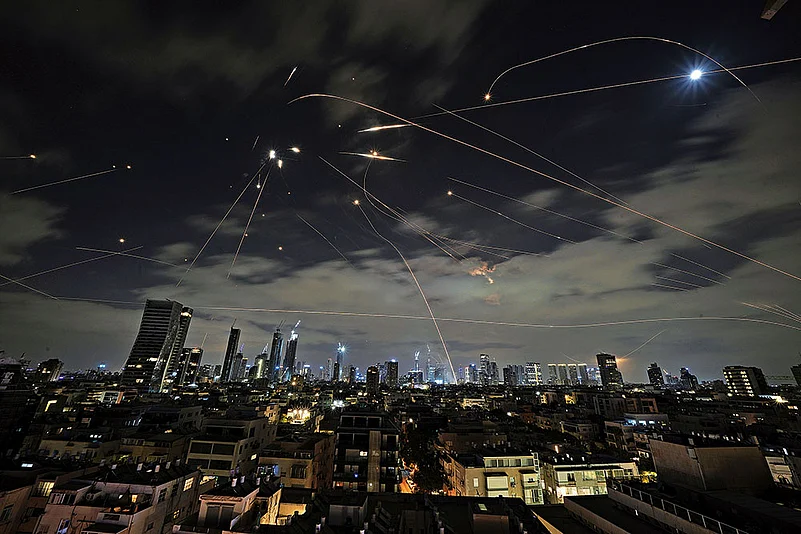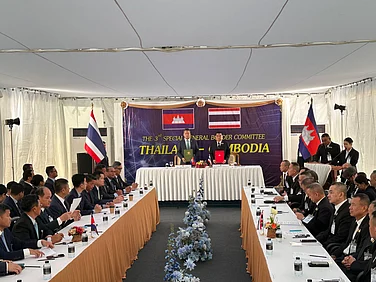Israel has hit nuclear centrifuges and military sites in Iran as confirmed by the International Atomic Energy Agency (IAEA) in the wake of escalated conflict between the two West Asian countries that has reportedly resulted in deaths of at least 585 people in Iran, including 239 civilians and injuries to 1,300 people.
The recent conflict began on June 13 when Israeli airstrikes targeting nuclear sites and military sites killed top army generals and nuclear scientists leading to retaliatory attacks by Iran with fighter jets and warplanes hitting Israel’s ‘Iron Dome’ air defence among other places.
On the sixth day of this conflict, Iran’s supreme leader Ayatollah Ali Khamenei rejected the United States’ calls for surrender with the stern warning, “Americans should know that any military involvement by the US will undoubtedly result in irreparable damage to them.”
But this rivalry between Iran and Israel with the involvement of the United States is not a recent development. It can be termed a ‘war in the making’.
Israel-Iran Ties 1948
The ties between Iran and Israel dates back to 1948 when West Asia was not open to accepting Israel as a new country. But Iran under Shah Mohammad Reza Pahlavi was an exception after it became a close ally of the United States during the Cold War. Both Iran and Israel required help from the United States to stay afloat and the then Prime Minister of Israel David Ben Gurion, with the goal of becoming an ally of non-Arab countries became closer to Iran.
According to reports, the two countries were involved in trade deals, arms sales, crude oil sales, and even shared intelligence information.
1957-1979
Iran and the United States signed a nuclear cooperation deal and 10 years later in 1967, the United States provided Iran with a nuclear reactor and enriched uranium fuel, which led to Iran signing the Nuclear Non-Proliferation Treaty that allowed it a civilian nuclear programme instead of a military one. Later, in 1970, Iran ratified the deal, which barred it from using the programme to build an atomic bomb.
1979
The Islamic revolution in Iran overthrew Shah Reza Pahlavi’s rule and shifted its relationship with Israel and the United States forever. The Islamic Republic under Ayatollah Ruhollah Khamenei was established in Iran and it advocated for Palestinians, to a point reportedly that Iran refused to accept Israeli passports and Iranians were banned from visiting ‘occupied Palestine’.

As per reports, Iran started to call Israel ‘enemy of Islam’ at this time.
However, the two countries still had one remaining area of common interest: Iraq. During the Iran-Iraq war in the 1980s, Israel reportedly sold arms to Iran and also helped it financially. But their ties went on to become worse with time.
Iran’s nuclear programme came under international pressure, which led to the United States cutting all diplomatic ties with Iran and also seizing Iranian assets and banning trade with the country.
1990s
The rivalry between Iran and Israel could be observed clearly after the Gulf War ended in 1991 and the United States established its global supremacy. Israel sided with the United States and saw Iran and its nuclear programme as a threat.
Some secret operations, proxy conflicts and open threats were recorded over the next few years.

2002-2009
Western intelligence services and an Iranian opposition group had revealed Iran’s secret Natanz nuclear enrichment facility in 2002 and a year later, Iran suspended the uranium enrichment after Britain, France and Germany tried to engage Iran in nuclear talks.
In 2006, Iran announced that it would restart uranium enrichment following the election of President Mahmoud Ahmadinejad.
Under President Barack Obama, as per reports, the United States and Iran opened a secret backchannel for messages in the sultanate of Oman in 2009.
2010-2022
In 2010, the United States and Israel reportedly created the Stuxnet virus, which damaged Iran’s nuclear centrifuges.
Iran announced a comprehensive nuclear agreement with world powers including the United States that limited Tehran’s enrichment of uranium in exchange for the lifting of economic sanctions in 2015.
But in 2018, Prime Minister Benjamin Netanyahu claimed that Israel had found data showing Iran ‘covering up’ its nuclear programme before signing the 2015 deal. This led to US President Donald Trump withdrawing from Iran’s nuclear deal with the world powers.
In the aftermath of the 2015 deal disintegration, a mysterious explosion took place at a centrifuge production plant at Iran’s Natanz nuclear enrichment facility in 2020. In the same year, top Iranian military nuclear scientist, Mohsen Fakhrizadeh, was killed. Iran blamed these attacks on Israel.
According to the Associated Press, Iran began enriching uranium up to 60 per cent, which is its highest purity and a technical step away from weapons-grade levels of 90 per cent.
2023-2025
Hamas militants entering Israel and killing 1,200 people, taking 250 hostage triggered another major war in West Asia in October 2023. Iran criticised Israel for its attacks on the Gaza strip.
In 2024, several incidents took place that further put Iran and Israel in polar positions, including an Israeli airstrike that demolished Iran’s Consulate in Damascus, Syria, killing 16 people, including two Iranian generals.

In April, 2024, Iran launched a missile and drone attack on Israel in response to the Israeli airstrike in Damascus. A few days later, a suspected Israeli strike hit an air defense system near an airport in Isfahan, Iran.
Hamas leader Ismail Haniyeh was killed by a suspected Israeli airstrike in July 2024 during his visit to Tehran. In September 2024, an Israeli airstrike killed Hezbollah leader Hassan Nasrallah, a group based in Lebanon and backed by Iran. Later in October, 2024, Iran launched its second direct attack on Israel, but most of the missiles were shot down by Tel Aviv.
After this, Israel openly attacked Iran for the first time. Israel launched several attacks on Iran’s nuclear and military sites on June 13, 2025. Warplanes and drones were deployed, killing top army generals and scientists. Further expanding the airstrikes, Israel targeted Iran’s energy industry.
MORE FROM THIS ISSUE
Iran launched retaliatory attacks on Israel, warning that US involvement in Israeli strikes would result in “all-out war”.
(Compiled by Trisha Majumder)
































